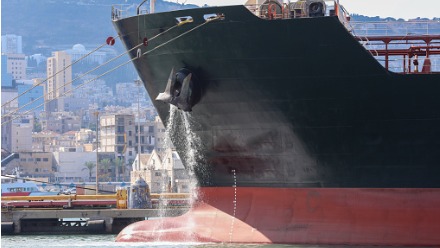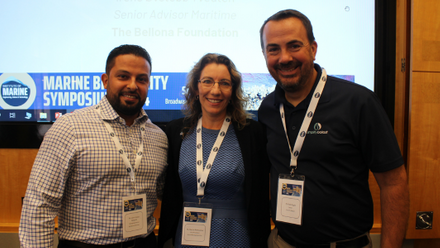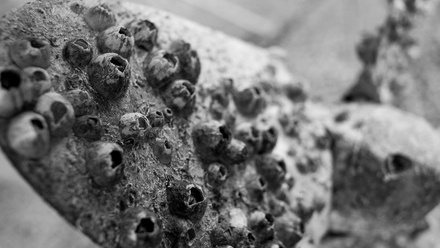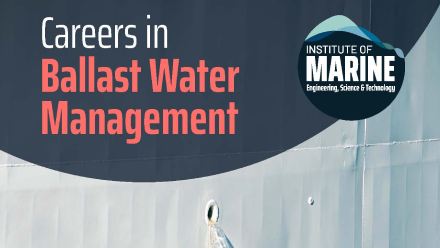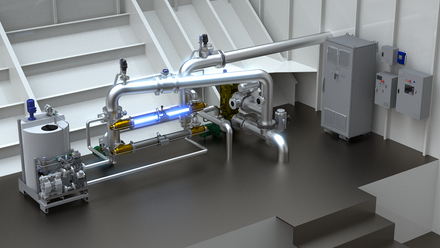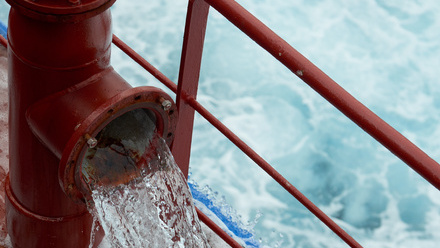Ballast Water Compliance Monitoring Workshop
Hundreds of ships are being built and retrofitted with ballast water management systems every month in order to comply with Ballast Water Management regulations. The Convention is now in implementation phase; the shipping industry is going through a ‘teething’ phase and identifying stages of approvals, treatment and testing that need more support. Once a system installation is complete, ships are now expected by some Administrations to undergo commissioning testing and when a management system is in service, ships are subject to ballast water sampling to determine compliance by port State control authorities in accordance with the “G2” guidelines.
The Ballast Water SIG hosted an virtual roundtable to act as a thought gathering exercise to explore the perspectives and expertise of different marine stakeholders directly involved in or affected by the Convention including; regulators, class societies, shipowners, ballast water management system (BWMS) manufacturers, compliance monitoring device manufacturers and testing facilities. This exercise followed the ‘life cycle’ of compliance monitoring; from BWMS installation / commissioning testing, to port State control.
Roundtable Summary
Life Cycle Part One - System Installation and Testing Prerequisites
In considering the needs and challenges for BWMS installation and initial (i.e. commissioning) testing, various topics arose that stakeholders believe would be beneficial to address to better support the shipping industry including; the role of contamination and ballast tank cleaning practices as part of the BWMS installation process, integration of the BWMS and ballast treatment into routine vessel operations, ways to deal with the impacts of poor ambient water quality in shipyards and developing mitigations for logistics challenges. Participants of the thought gathering exercise suggested that potential development of standard procedures that address these aspects would be valuable for all stakeholders. The installation process requires approval from class societies that check safety and statutory compliance aspects and then issue the International Ballast Water Management Certificate (IBWMC) on behalf of the flag; the process includes reviewing piping diagrams, checking installation, and conducting initial survey and IMO commissioning testing as needed. Participants discussed that there is greater clarity needed on commissioning testing, especially to improve vessel crew understanding after handover by the BWMS manufacturer to prepare for biological performance testing, IMO statutory requirements and IBWMC issuance. In situations where a commissioning test is unsuccessful, there are 4 likely points where queries about the BWMS installation will be focused; manufacturer (is there a system failure?); design (was the system not designed properly?); installation (was the system installed incorrectly?); owner use (was the system used properly?).
Participant experiences to date have shown that unsuccessful tests after BWMS installation are largely attributed to lack of, or insufficient,tank cleaning including removal of sediments, but given costs and logistical challenges it is important to clarify what is meant by ‘clean’ (e.g. 3x flushed through with freshwater?) and the best approaches for tank cleaning (e.g. emptying ballast tank(s) for commissioning purposes?). The practicalities of tank cleaning are not easy and experiences are not typically shared amongst the shipping community, limiting availability of information on practical and cost effective approaches. Given the frequency and importance of these issues expressed by the participating stakeholders, development of published best practices and lessons learned may be beneficial to support the industry as more BWMS are installed.
The importance of biological and BWMS operational performance tests is widely accepted; however, can be overshadowed when certain conditions are not available. For example, ship owners face difficulties when their business needs clash with testing logistics such as testing organization, lab or surveyor availability in remote port locations, or when vessels dock in freshwater ports that may not be suitable for certain BWMS to operate per specification. Crews can be affected when commissioning testing requirements and operational challenges collide. For example, when a ship is coming out of dry dock it needs water to run ballast pumps, and sometimes sea water for electrolytic systems, and untreated water may be in the ballast tanks, which introduces contamination and impacts ability for crew to operate the BWMS. Regulators need to consider these challenges when determining if timeline extensions are warranted, and vessel owners need to consider these aspects in their shipyard planning / BWMS installation schedules and during coordination with the testing organization.
Life Cycle Part Two - BWMS Commissioning Testing
The BWMS installation discussion that took place demonstrates the direct link to the next ‘life cycle stage’ of BWMS commissioning testing. During these stakeholder discussions experiences were shared relating to commissioning testing requirements and confusion caused by differing interpretations, the distinction and current use of indicative analysis and detailed analysis methods, experiences with unsuccessful tests, and costs. Classification society and regulatory stakeholders reiterated that commissioning testing is not a re-test of the type approval; while type approvals recognise a system in principle, commissioning testing is necessary to ensure proper installation and function. A significant current challenge is the differing interpretations of commissioning testing requirements between classification societies, flag administrations and testing organizations, and there is a mixture of detailed analysis and indicative analysis methods being used. In this regard, development of a unified interpretation could be valuable for industry stakeholders.
An often overlooked aspect of commissioning testing is the BWMS self-monitoring parameters that BWM.2/Circ.70 specifies should be evaluated. As noted in ‘Life Cycle Part I’ discussions, commissioning may not be able to take place at the site of installation, so it is important to consider local conditions and BWMS system design limitations when planning testing (i.e. can the BWMS properly operate in the local conditions?). There is pressure to ensure commissioning testing is conducted correctly the first time as costs are incurred and crews need to be supported to manage both costs and administrative burdens to make the process as easy as possible for everyone involved. Some cases show vessels simply cannot perform testing in the location where the BWMS is fitted and a short-term IBWMC may be allowed until the commissioning testing requirement can be fulfilled. In these cases, ballast water exchange and/or contingency measures may be used, as applicable to a vessel and as allowed; this may include a need to inform the next flag State of the condition.
Participants from classification societies indicated they take an overarching view of the whole process and it was noted that the knowledge and skills of the testing organizations is critical. With respect to how testing organizations are accepted to perform commissioning testing, key areas include; accuracy and suitability of the testing method(s) being used; qualifications of the testing organisation and staff; understanding of how sampling methodology can affect the results; and knowledge of how BWMS work. Experiences shared by testing organizations, regulators, and ship owners indicate that unsuccessful commissioning test results are most commonly related to the largest organism size class (≥ 50 µm, generally considered as zooplankton). Further, the cause of unsuccessful commissioning tests often relates to sample contamination due to uncleaned / insufficiently cleaned ballast tanks, as well untreated vessel piping and/or leaking valves in the vessel ballast piping system. Indicative analysis tools are proposed as a faster and cheaper alternative to monitor functionality of treatment systems and give an indicator of compliance to the Convention’s D-2 standard. However, availability of verified indicative analysis methods and some compatibility issues with some systems/mode of use are currently limiting. There are currently efforts both within the IMO and ISO to develop a standard protocol for verification of compliance monitoring devices to facilitate availability of verified indicative analysis methods.
Experiences from testing facilities suggest that the direct costs of using detailed analysis compared to indicative analysis are insignificant. This is because the majority of commissioning testing costs are associated with labour (skilled technicians / biologist) and logistics (travel, getting onboard and collecting samples), which are generally the same between indicative and detailed analysis methods.
Life Cycle Part Three - Port State Control
Experiences shared during this ‘life cycle’ discussion revealed that several port States have conducted extensive onboard and/or laboratory testing, or are in the process of performing detailed investigations, of currently available compliance monitoring devices. Device performance, functionality, portability, usability, and required skill level are some of the aspects being considered. Some port States are currently using compliance monitoring devices as part of standard inspections but there is little data publicly available for other ports or stakeholders to use and review. Improving willingness to share findings will really help to support wider implementation of the Convention; to identify common problems and the practical steps to mitigate them. In some States, national regulations are being drafted to bring in-line with the needs of the Convention including evaluating availability of appropriately designed sampling facilities for representative sampling. A significant amount of work ongoing from these evaluations and case studies can be fed into the IMO compliance monitoring device standard verification protocol that is under development.
Experiences from port State control corroborates that of testing facilities in that most problems encountered involved the ≥50 µm size class. If there are installation issues with a BWMS or any sample contamination, the analysis of organisms ≥50 µm will often show that. Hence, for port State control testing to have value, analysis of the ≥50µm organism size class is key. For a correct analysis of the number of organisms ≥50µm, representative sampling of the ballast water being discharged is needed and typically requires substantial volumes to be sampled. Both port State control inspectors and ship owners are looking for an efficient inspection process. Inspections can be intensive, even before the needs for checking ballast water are considered, and both stakeholders should have a clear process to manage accessibility and sampling with little or no disruption to normal operations.
Inspections already take several hours, delays in collecting a suitable sample or providing support are costly and only increase when crews and inspectors are unprepared for unplanned visits which is a hindrance to normal operations. It raises the question if guidelines for streamlining these processes can be developed; high level guidelines on how crew can prepare for testing and to get a right sample would be helpful in reducing time onboard. Administrations face similar problems, especially for States like Brazil that have long coastlines which means that when indicative analysis results necessitate further evaluation of samples, a lab can be very far from the port of call and sample holding times are likely to be exceeded within the required before analysis can be conducted.

